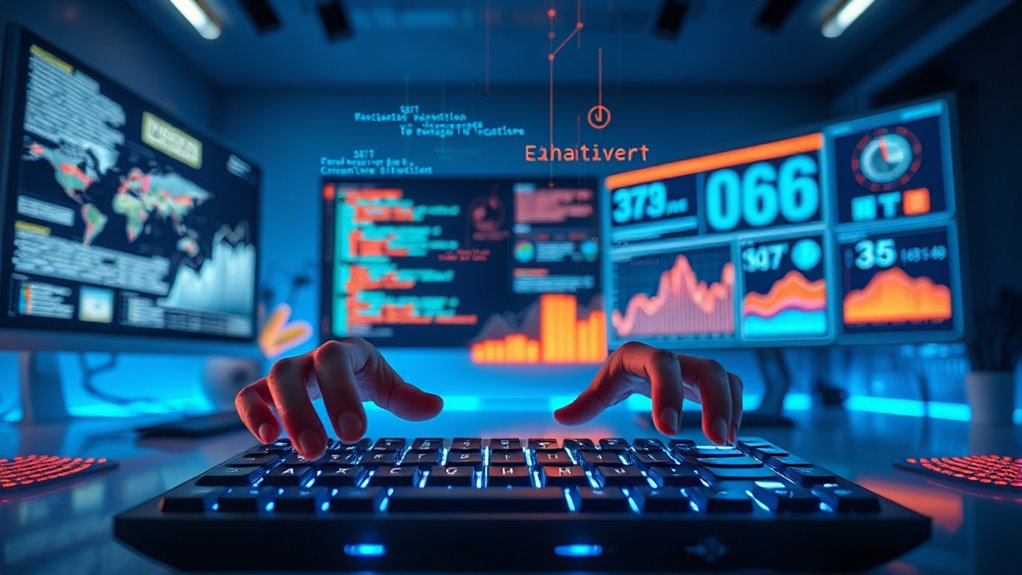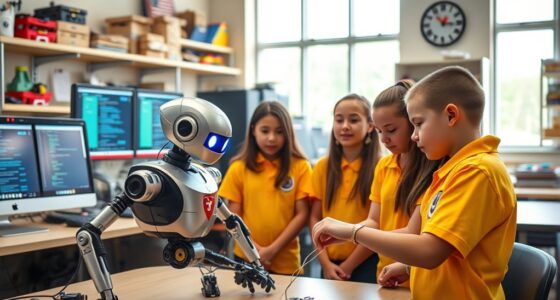Yes, large language models are increasingly automating creative tasks like coding, copywriting, and content creation across industries. They help generate personalized marketing copy, streamline coding with conversational tools, and assist in producing various content types faster and more efficiently. While they boost productivity, challenges like factual errors and biases remain. To explore how these tools are transforming creative work and what opportunities and risks they bring, keep exploring further.
Key Takeaways
- LLMs automate routine aspects of creative tasks like code generation and content creation, increasing efficiency and reducing manual effort.
- They support personalized marketing, copywriting, and content workflows, enabling scalable production across multiple channels.
- While capable of generating creative outputs, models often face challenges with nuanced, context-sensitive, and factual content.
- Ethical concerns, biases, and accuracy issues limit full reliance on LLMs for high-stakes or highly nuanced creative work.
- Overall, LLMs augment creative tasks but are unlikely to fully replace human creativity, emphasizing collaboration rather than automation.
The Rise of LLMs in Creative Industries

The rise of LLMs in creative industries has transformed how content is produced and optimized. Since late 2022, their adoption has skyrocketed by 1310%, enabling seamless integration into various workflows. SaaS API models make deploying LLMs scalable and cost-effective, helping create everything from scripts to marketing copy more quickly. Creative professionals now use these tools to improve efficiency and speed, while studios often rely on proprietary LLMs to maintain control over their content and data. Additionally, understanding how to manage and adapt to content storage and security is becoming increasingly important as AI-generated content grows more prevalent. As foundational models advance, their ability to process and generate complex creative outputs continues to expand significantly, opening new opportunities for innovation. The integration of content management systems is also crucial for organizing and safeguarding AI-generated assets effectively. Furthermore, ongoing developments in AI customization allow for more tailored and relevant creative outputs, enhancing their utility across industries. Effective content curation is essential to ensure the quality and relevance of AI-produced material, especially as the volume of generated content increases. However, a skills gap persists, with many creatives not yet fully equipped to utilize these tools effectively. This rapid adoption signals a shift toward AI-driven processes that complement human creativity, opening new possibilities while also highlighting the need for training and adaptation in the industry.
Key Capabilities of Language Models in Content Generation

How do language models excel at generating high-quality content? They leverage vast textual data and sophisticated architectures to produce coherent, relevant text from prompts. These models adapt to specific domains, synthesizing knowledge across various sources, making their output tailored and accurate. They also excel at tasks like summarization, translation, and question-answering with little extra training. Content coherence is a key strength—they ensure that generated text makes sense in context, mimicking human language patterns. Some models even process multiple data types, like images or audio. Additionally, training data diversity plays a crucial role in shaping a model’s ability to generate high-quality content, as the diversity and quality of data directly impact its performance and accuracy. Understanding the importance of model architecture helps clarify how these systems achieve such high levels of performance. Moreover, advancements in AI-driven optimization techniques continually enhance the quality and efficiency of content generation. For example, fine-tuning methods allow models to better align with specific tasks or styles, further improving output relevance. Incorporating context-awareness enables models to generate more nuanced and precise content tailored to the user’s needs. Here’s a quick overview:
| Capability | Description |
|---|---|
| Text Generation | Produces fluent, contextually relevant content |
| Domain Adaptability | Tailors output to specific fields or styles |
| Natural Language Processing | Summarizes, translates, answers questions efficiently |
| Multimodality | Handles text, images, or audio in content creation |
How LLMs Are Transforming Coding and Software Development

Large language models are revolutionizing coding and software development by enabling automated code generation, which helps you save time and boost productivity. Tools like GPT and Codex can produce code rapidly, reducing manual effort and speeding up project completion. They facilitate a conversational approach, allowing you to interact in plain language, making development more accessible. LLMs offer problem-solving support, providing insights on complex challenges, while also fostering collaboration through immediate feedback and suggestions. These models can optimize existing code for better efficiency and readability, and help new developers learn faster. Recent research indicates that LLMs are increasingly integrated into various stages of the software engineering workflow, enhancing efficiency across the board. This integration can also support understanding and managing software environments, which is crucial for developing reliable applications. Additionally, ongoing advancements in model training techniques continue to improve their accuracy and capabilities. Furthermore, the integration of LLMs into development workflows is making it easier to incorporate automated testing and quality assurance processes. As these models become more sophisticated, they are also aiding in security vulnerability detection, helping to mitigate potential risks early in the development cycle. Incorporating collaborative tools that utilize LLMs further streamlines teamwork and project management. However, challenges remain, such as ensuring accuracy and managing security risks. Overall, LLMs are transforming development workflows, making coding more efficient, collaborative, and innovative.
The Impact of LLMs on Copywriting and Marketing Tasks

LLMs are transforming copywriting and marketing by enabling faster, more personalized content creation. You can now generate tailored ad copy and product descriptions at scale, improving audience targeting and engagement. Advanced Natural Language Processing techniques allow for more nuanced understanding of customer preferences, leading to even more effective messaging. However, challenges remain in ensuring creative accuracy and emotional resonance, often requiring human refinement. Additionally, Etsy SEO strategies can help sellers optimize their listings to increase visibility and sales. Furthermore, a free online tool to convert text styles can assist writers in testing different capitalization formats to enhance readability and presentation. Leveraging professional voice talent can also elevate the authenticity and appeal of marketing content, ensuring it resonates effectively with target audiences.
Enhanced Content Generation Capabilities
The advent of advanced language models has markedly enhanced content generation, transforming copywriting and marketing tasks. These models now produce high-quality content quickly and efficiently, saving you time and effort. They can generate diverse marketing materials, from social media posts to ad copy, across multiple channels and languages. Here are four key impacts:
- Increased speed in creating content, reducing turnaround times.
- Automation of routine tasks like product descriptions and email drafts.
- Consistent brand voice and standardized messaging across outputs.
- Support for various content types, boosting campaign flexibility.
While LLMs excel in speed and consistency, they still face challenges in producing nuanced, context-sensitive content. Overall, these capabilities are reshaping how marketing teams operate, enabling faster, more scalable content workflows.
Personalization and Audience Targeting
How are marketers leveraging advanced AI to deliver more precise and personalized campaigns? By analyzing vast amounts of consumer data, LLMs identify distinct audience segments based on behavior, preferences, and demographics. They detect nuanced patterns in unstructured text like social media posts, enabling more accurate targeting without relying on cookies or user IDs. AI-driven segmentation creates scalable, detailed groups aligned with brand goals, improving campaign effectiveness across digital platforms. LLMs also craft hyper-personalized content by tailoring messages to specific segments and individual preferences, boosting engagement. They analyze customer sentiment and context to understand emotions and underlying attitudes, allowing marketers to refine strategies and respond to trends quickly. This approach enhances trust and privacy compliance, making campaigns more relevant while respecting consumer data.
Challenges in Creative Accuracy
While large language models have revolutionized creative tasks like copywriting and marketing, their accuracy remains a significant challenge. You might rely on them for quick content, but inconsistencies and errors can undermine trust. Here are key issues to contemplate:
- Variable accuracy: Models like ChatGPT-4 reach about 76%, but others hover around 50% or less, risking misinformation.
- Inconsistent responses: Repeated queries can yield different answers, reducing reliability in campaigns.
- Factual errors: Hallucinated or incorrect info, especially on complex topics, can slip through.
- Source verification needs manual checks: References often are fabricated or incomplete, requiring human oversight to confirm authenticity.
These challenges mean you must fact-check diligently, as even advanced tools can fall short in delivering precise, trustworthy content.
Challenges and Limitations in Creative and Business Automation

You need to recognize that LLMs can produce confident but incorrect information, known as hallucinations, which can mislead your decisions. They also tend to reflect biases from their training data, raising ethical concerns and fairness issues. These limitations make it challenging to rely solely on LLMs for complex creative and business tasks without careful oversight.
Hallucinations and Biases
Hallucinations and biases pose significant hurdles in integrating large language models (LLMs) into creative and business automation. Hallucinations are outputs that sound plausible but are factually inaccurate, occurring in 2.5% to 8.5% of responses, and over 15% in high-stakes fields like healthcare, finance, and law. They often carry high confidence, making detection tricky. Biases from training data can reinforce stereotypes, cultural biases, and unfair representations, risking reputational damage and ethical issues. To address these challenges, consider:
- Implementing detection tools to flag hallucinated content.
- Improving training methods to reduce false outputs.
- Using grounding techniques to anchor responses to factual data.
- Applying domain-specific mitigation strategies to limit bias influence.
Understanding these limitations is essential for responsible AI deployment.
Complex Task Limitations
Large language models (LLMs) face significant hurdles when tackling complex tasks in creative and business automation. They can simulate logical rules verbally but struggle to chain them into reliable conclusions. Errors accumulate with each reasoning step, and their probabilistic nature makes mistakes inevitable. Additionally, LLMs lack transparency, often failing to show their “chain of thought,” which hampers error detection. They also struggle with nuanced inputs, missing subtleties and cultural references.
| Limitation | Impact | Example |
|---|---|---|
| Verbal vs. Actual Logic | Fail to connect reasoning steps, leading to errors | Multi-step reasoning failure |
| Token Limitations | Restricts processing of extensive inputs | Handling lengthy documents |
| Knowledge Static | Outdated information, no real-time updates | Obsolete industry data |
| Creativity | Mimics but lacks genuine innovation | Unique ideas are rare |
| Context Understanding | Misses nuances, cultural subtleties | Misinterpretations |
Ethical Concerns Rise
As automation with LLMs advances in creative and business fields, ethical concerns are becoming increasingly prominent. You need to consider several challenges.
- Data privacy and security: Large datasets raise worries about intrusive data collection and compliance with privacy laws, making transparency essential.
- Bias and discrimination: LLMs can mirror societal biases, risking discriminatory outputs; ongoing bias testing and dataset curation are essential.
- Copyright and ownership: Training on copyrighted material raises legal issues, requiring clear guidelines and evolving legal frameworks for AI-generated content.
- Environmental impact: Training LLMs consumes significant resources, leading to high carbon emissions; sustainable techniques and energy-efficient hardware are necessary.
Addressing these concerns is imperative for ethical and responsible AI integration in creative and business sectors.
Ethical Considerations and Risks of AI-Generated Content

Have you considered the ethical risks that come with AI-generated content? Bias and discrimination are major concerns, as AI models can amplify existing societal prejudices, leading to unfair outputs against race, gender, or other groups. Without diverse datasets, these biases worsen, potentially perpetuating systemic inequalities in hiring or content moderation. There are also copyright issues; AI often pulls from copyrighted works without permission, risking infringement and unfair use of creators’ work. Misinformation is another danger—deepfakes and fake news can spread falsehoods, inciting unrest or harm. Transparency is often lacking, making it hard to identify AI origin or assign responsibility for harmful content. These risks threaten trust, social cohesion, and the integrity of creative professions, demanding careful ethical oversight.
Future Trends: Enhancing Transparency and Niche Performance

Advancements in AI transparency are making it easier to understand how models generate their outputs, fostering greater trust and accountability. You’ll see increased transparency metrics, like the Transparency Index, showing continuous improvements—Anthropic, for example, boosted its score by 15 points to 51 between October 2023 and May 2024. Companies are adopting explainability practices to trace outputs back to data sources, improving accuracy and compliance. Significant progress in model performance, driven by Stanford’s research, further enhances transparency. In conclusion, ongoing efforts in regulatory compliance ensure AI models meet evolving legal standards. To stay ahead, consider these key trends:
- Increased transparency metrics and scores
- Focused explainability and source tracing
- Improved performance in niche domains
- Continuous efforts for regulatory compliance
Opportunities and Risks for the Creative Workforce

The growing transparency and performance improvements in AI models open new opportunities for the creative workforce, while also presenting significant challenges. You can use LLMs to enhance productivity through research, editing, and organization, allowing you to focus on more complex tasks. AI-driven tools expand creative possibilities—think AI-generated art and music—that push your boundaries. Collaborating with AI can spark innovation, blending human intuition with machine efficiency. Additionally, AI makes creative work more accessible by automating repetitive tasks, enabling more people to participate. However, risks exist. AI might displace jobs in writing and design, making certain skills obsolete. Overdependence could weaken your creativity, and ethical concerns around authorship and ownership may arise. Balancing these opportunities and risks is vital for your future in creative industries.
Frequently Asked Questions
How Do LLMS Handle Highly Specialized or Technical Creative Tasks?
You might wonder how LLMs manage highly specialized or technical creative tasks. They adapt by being trained on domain-specific data, which helps them understand complex concepts. You can also fine-tune these models to focus on particular fields like healthcare or law. While they handle many technical details well, you should still be cautious, as they might lack deep expertise or nuanced understanding in very niche areas.
What Measures Are in Place to Prevent Ai-Generated Misinformation?
Imagine a digital fortress guarding truth itself—that’s how measures to prevent AI-generated misinformation work. You’ll see advanced AI systems analyzing language patterns, flagging false content in real time. Watermarking and provenance tags act like digital fingerprints, tracing content origins. Industry collaborations and transparency efforts serve as vigilant guards, while media literacy campaigns empower you to spot fakes. These combined efforts create a layered shield, helping keep misinformation at bay and safeguarding your digital experience.
Can LLMS Truly Replace Human Creativity in Content Creation?
You wonder if LLMs can truly replace human creativity in content creation. While they excel at generating coherent, relevant text and automating repetitive tasks, they lack emotional depth, nuance, and original ideas that come naturally to humans. LLMs serve best as tools to enhance your creative process, not replace it. Your unique insights, experiences, and imagination remain essential for truly authentic and innovative content.
How Do LLMS Impact Employment in Creative Industries?
You might think creative jobs are safe, but LLMs are shaking things up. They automate routine tasks and create new opportunities, meaning your role could evolve rather than disappear. While some freelancers face risks, others find new ways to stand out with AI tools. The key is to adapt and develop skills that complement AI, turning challenges into chances for growth. Don’t put all your eggs in one basket—stay flexible.
What Are the Long-Term Ethical Implications of Deepfake and Synthetic Content?
The long-term ethical implications of deepfake and synthetic content challenge your sense of trust and authenticity online. You might struggle to distinguish real from fake, risking misinformation, privacy violations, and identity theft. As these technologies become more sophisticated, you’ll need to navigate a world where consent is often overlooked, and malicious actors can manipulate perceptions. This raises urgent questions about regulation, responsibility, and protecting individuals’ rights in an increasingly synthetic digital landscape.
Conclusion
As you navigate this landscape, remember that AI is a tool, not a replacement. Like a brush in your hand, it can create masterpieces or mere sketches—depending on your mastery. Embrace the opportunities, but stay vigilant of the risks. The future of creative work isn’t about machines taking over; it’s about humans guiding the brush with vision and purpose, painting a world where technology amplifies your unique voice.









